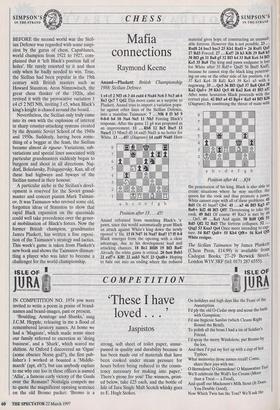SIMPSON'S
IN-THE-STRAND
BEFORE the second world war the Sicil- ian Defence was regarded with some suspi- cion by the gurus of chess. Capablanca, world champion from 1921 to 1927, com- plained that it 'left Black's position full of holes'. He rarely resorted to it and then only when he badly needed to win. True, the Sicilian had been popular in the 19th century with British masters such as Howard Staunton. Aron Nimzowitsch, the great chess thinker of the 1920s, also revived it with the provocative variation 1 e4 c5 2 Nf3 Nf6, inviting 3 e5, when Black's king's knight is chased around the board.
Nevertheless, the Sicilian only truly came into its own with the explosion of interest in sharp counter-attacking systems created by the dynamic Soviet School of the 1940s and 1950s. Suddenly, having been some- thing of a beggar at the feast, the Sicilian became almost de rigueur. Variations, sub- variations and special lines associated with particular grandmasters suddenly began to burgeon and shoot in all directions. Naj- dorf, Boleslaysky, Polugayevsky, Kan, all of these had highways and byways of the Sicilian named in their honour.
A particular niche in the Sicilian's devel- opment is reserved for the Soviet grand- master and concert pianist Mark Taiman- ov. It was Taimanov who revived some old, forgotten ideas of Staunton to show that rapid Black expansion on the queenside could well take precedence over the gener- al mobilisation of Black's forces. Now the former British champion, grandmaster James Plaskett, has written a fine exposi- tion of the Taimanov's strategy and tactics. This week's game is taken from Plaskett's new book and shows the Taimanov disman- tling a player who was later to become a challenger for the world championship.
Mafia connections
Raymond Keene
Anand—Plaskett: British Championship 1988; Sicilian Defence.
1 e4 c5 2 Nf3 e6 3 d4 cxd4 4 Nxd4 Nc6 5 Nc3 a6 6 Be3 Qc7 7 Qd2 This move came as a surprise to Plaskett. Anand tries to import a variation popu- lar against other lines of the Sicilian Defence, into a mainline Taimanov. 7 ... Nf6 8 t3 b5 9 0-0-0 b4 10 Na4 Ne5 11 Nb3 Forcing Black's response. After the game 11 g4 was proposed as an improvement. 11 ... Rb8 12 Bc5 BxcS 13 Naxc5 13 Nbxc5 d5 14 exd5 NxdS is no better for White. 13 ...d5! (Diagram) 14 exd5 NxdS Here
Anand refrained from snatching Black's 'a' pawn, since this would automatically grant Black an attack against White's king down the newly opened 'a' file. 15 f4 Nd7 16 Nxd7 Bxd7 17 f5 0-0 Black emerges from the opening with a clear advantage, due to his development lead and attacking chances. 18 Bet Rfd8 19 Bf3 Ba4! Already the white game is critical. 20 fxe6 Bxb3 21 ext7+ K18! 22 axb3 Nc3! 23 Qxd8+ Hoping to bale out into an ending where the reduced
SIMPSON'S IN-THE-STRAND material gives hope of constructing an unassail- able fortress. However this is not possible. 23 • • • RxdS 24 bxc3 bxe3 25 Kbl Rxdl + 26 Rxdl Qa5 27 Rd3 Forced. 27 ...Kxf7 28 h3 K16 29 Bab b5 30 Bf3 g6 31 Ba8 g5 32 Bf3 h4 33 Ba8 Ke6 34 Bf3 Ke5 35 Ba8 The king and pawn endgame is lost for White after 35 Rd5+ Qxd5 36 Bxd5 Kxd5, because he cannot stop the black king penetrat- ing on one or the other side of his position, e.g. 37 Kcl Ke4 38 Kdl Ke3 39 Kel a5 with a zugzwang. 35 ... Qc5 36 Bf3 Qa5 37 Ba8 Qb4 38 Ka2 Qa5+ 39 Kb1 Qc5 40 Ka2 Ke6 41 Bf3 a5! After some hesitation Black proceeds with the correct plan. 42 Bh5 a4 43 Bg4+ Ke5 44 Bf3 Kf4 (Diagram) By combining the threat of mate with the penetration of his king, Black is also able to create situations where he may sacrifice the queen for the rook and thus promote a pawn. White cannot cope with all of these problems. 45 Bd5 Or 45 bxa4? Qb4. 45 ... a3 46 Bf3 K83 41 Ba8+ Kf2 48 Bf3 Qf5! Threatening to take the rook. 49 Bdl Of course 49 Rxc3 is met by 49 Qe5. 49 ...Kel And again. 50 Rd8 Qf6 51 Rd5 Qf2 52 Rd3 The fortress collapses. 52 .• • Qxg2 53 Kxa3 Qe4 Once more intending to cap- ture. 54 Rd7 Qa8+ 55 104 Qt8+ 56 Ka4 Qf5 White resigns.
The Sicilian Taimanov by James Plaskett (Chess Press, £14.99) is available from Cadogan Books, 27-29 Berwick Street, London W1V 3RF (tel: 0171 287 6555).


































































 Previous page
Previous page